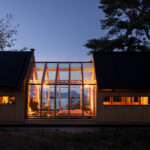This feature has been created in collaboration with urbanNext, a multi-platform aimed at developing, disseminating and distributing content centered on architecture through a focus on the contemporary human milieu and its challenges. Architizer features a weekly discussion from urbanNext’s journals to support its investigation of urban conditions and innovations facing the architectural profession today.
“I would hope that our future graduates are not impotent in this world that is rapidly changing,” says Anupama Kundoo in an interview with urbanNext. Kundoo, the founding principal of her internationally renowned architecture firm Anupama Kundoo Architect, spoke with urbanNext at the 2016 Venice Biennale earlier this year about the urgent challenges facing architectural education.

Anupama Kundoo in her installation for the 2016 Venice Biennale
For the architect, who recently celebrated 25 years of her independent practice, Kundoo worries our increasing reliance on the internet will obscure young architects’ opportunities to engage with the tangible realities of the profession. “It cannot replace the other things that we have developed as architects throughout our evolution as a profession,” says Kundoo, “ … If the level of knowledge is not more than our forefathers or at least equal, that is not progress for me.”
For her contribution to the 2016 Venice Biennale, Kundoo rebuilt an affordable housing prototype that her firm has been developing in India, the Full Fill Houses. These prototypes are constructed by arranging a combination of ferro-cement boxes, which function both as the structural foundation of the home and as furniture and storage elements, a technique attempt to respond to a number of challenges facing society, most notably homelessness, the affordability crisis and the threat of climate change.

© Giannesini
Full Fill House prototype
“I believe in design as method to design social transitions,” says Kundoo, “Architecture is the design of the synthesis between all issues. We have to think about geography, engineering, economy, humanities.” It is precisely because Kundoo believes so firmly in architecture’s social responsibility that she finds it crucial that hands-on experience, or confrontations, as she calls them, accompany a student’s architectural education. “These confrontations have a chance to inform their design,” she says.

© Giannesini
This duality between research and practice is also critical to Kundoo’s exhibition work and is reflected in the decision to construct an experiential pavilion at the Venice Biennale, to move architectural research beyond the representational realm. “When you visit architecture, you have to inhabit the space in real scale with your body and have an experience of it … and not only have an intellectual experience.”
{% partner_block logo=”/static/img/partners/urbannext.png” description=”urbanNext is a multi-platform aimed at developing and distributing architectural content.” call_to_action=”Visit urbanNext →” url=”https://urbannext.net/” %}









